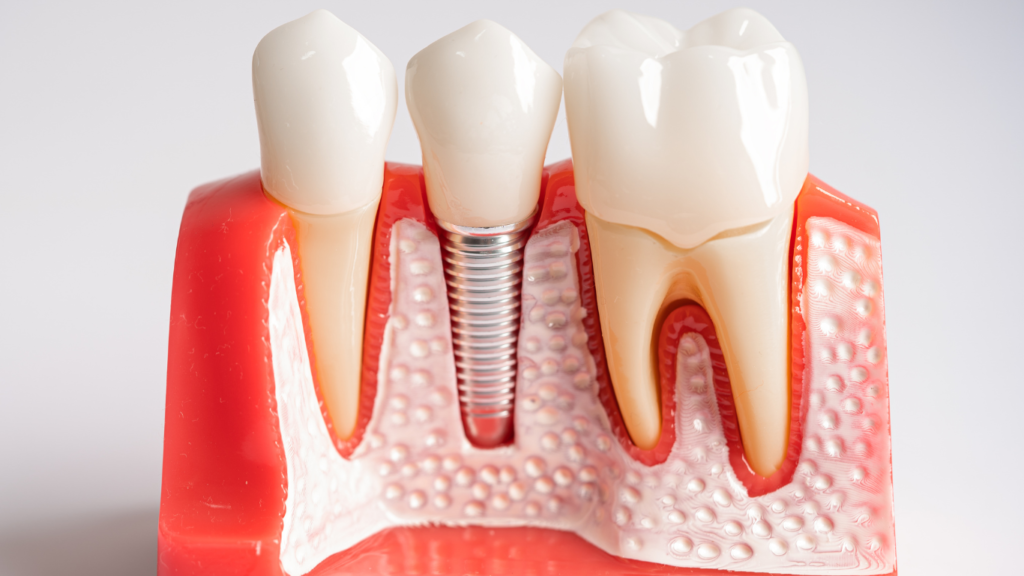When faced with a tooth that’s damaged or decayed beyond repair, the decision between a root canal and a dental implant can be daunting.
Both procedures offer solutions for preserving your smile and restoring oral health, but how do you know which option is best for you?
In this article, we’ll explore the differences between root canals and dental implants, as well as factors to consider when making this important decision.
Factors That Lead to Requiring a Root Canal or Dental Implant
Root canals or dental implants are needed for a cracked tooth, a deep cavity, issues from a previous filling, or a bacterial infection.
Unfortunately, antibiotics are not effective in treating root canal infections. However, they can help to treat infection that spreads beyond the root and causes swelling.
Symptoms that mean you might need a root canal or dental implant:
- Pain while chewing or biting
- Pimples on the gums
- A chipped or cracked tooth
- Sensitivity to hot or cold
- Swollen or tender gums
- Decay or darkening of the gums
- The tooth becoming a darker color
- A loose tooth
Before exploring treatment options, your dentist will take X-rays of the affected tooth.
They may perform other tests to determine whether the tooth pulp is dead, infected or inflamed to confirm that you need to explore root canal treatment or a dental implant process.
Understanding Root Canals
A root canal is a procedure designed to save a tooth that is severely infected or decayed.
Before having root canal treatment, you’ll usually be given a local anesthetic, which means that the procedure should be painless, and no more unpleasant than having a filling.
During a root canal, the dentist removes the infected pulp from inside the tooth, cleans and disinfects the root canals, and seals the tooth to prevent further infection.

Pros of Root Canals
- Preserves the natural tooth structure
- Less invasive than dental implants
- Cost-effective compared to implants
- Shorter treatment time
Cons of Root Canals
- May require additional treatments or retreatment in the future
- Can weaken the tooth over time
- Success rates vary depending on the severity of the infection
Exploring Dental Implants
Dental implants are a popular option for replacing missing or irreparably damaged teeth. An implant consists of a titanium post that is surgically implanted into the jawbone, topped with a custom-made dental crown that resembles a natural tooth.
To elaborate, a dental implant is a three-part structure that works in harmony to replicate the natural structure and function of a tooth.
The key components include:
Implant Fixture: The titanium post that is surgically placed into your jawbone. This serves as the artificial tooth root, providing stability and support for the replacement tooth. It fuses with the bone through a process called osseointegration (or bone grafting), creating a secure and lasting bond.
Abutment: Once the implant fixture has integrated with the jawbone, an abutment is attached to it, and connects the implant fixture and the crown.
Crown (replacement tooth): The crown is the visible part of the dental implant that looks like a natural tooth. It is designed to perfectly match the color, shape and size of your existing teeth before it is attached to the abutment.

Pros of Dental Implants
- Provides a permanent solution for tooth loss
- Offers stability and functionality similar to natural teeth
- Prevents bone loss and preserves facial structure
- Last longer than a root canal and crown
Cons of Dental Implants
- Requires surgery and a longer recovery period
- More expensive upfront cost compared to root canals
- Not suitable for everyone, especially those with poor bone density or gum health
Root Canals vs. Dental Implant – Factors to consider
When deciding between a root canal and a dental implant, several factors should be taken into consideration:
Tooth Condition: Is the tooth salvageable with a root canal, or is it too damaged for preservation?
Oral Health: Are there underlying issues such as gum disease or bone loss that may affect the success of either procedure?
Budget: What are your financial considerations, including upfront costs and potential long-term expenses? Does your dental insurance cover the procedure?
Personal Preferences: Do you prefer to preserve your natural tooth or opt for a permanent replacement with a dental implant?
Consulting with Your Dentist
Ultimately, the decision between a root canal and a dental implant should be made in consultation with your dentist.
Your dentist will evaluate your oral health, discuss your treatment options, and help you make an informed decision based on your individual needs and preferences.
In Conclusion
Whether you choose a root canal or a dental implant, both treatments offer effective solutions for restoring your smile and maintaining oral health.
By understanding the differences between these procedures and considering factors such as tooth condition, oral health, budget, and personal preferences, you can make the right choice for your smile.
Don’t hesitate to reach out to your dentist for guidance and support throughout the decision-making process.
Modern Day Dental – Dental Implants – St. Johns, FL
While root canals have their place, dental implants have revolutionized the field of dentistry, offering a superior solution for missing teeth that not only restores your smile in the most optimal way, but also improves your overall oral health and quality of life.
With their natural look, durability, and functional benefits, dental implants stand as the best option for achieving a confident and complete smile.
If you’re considering tooth replacement options and are located in or around St. Johns Florida, consult with the experts at Modern Day Dental to explore how dental implants can transform your oral health journey!

